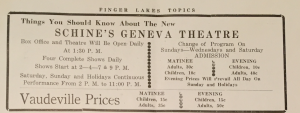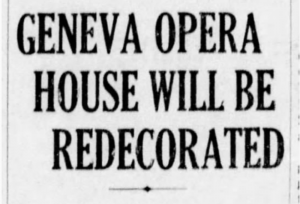SMITH HISTORY BLOG: Who Built It Part I
By Chris Woodworth
One of the major questions that has been vexing us in our research into The Smith’s history is: who built it? We know the names of the major funders of The Smith as well as the designers who created the original plans for the 1894 structure. But who were the contractors, artisans, craftspeople who toiled daily to bring the original buildings to life on Seneca St.? We are still looking for answers and we may never find them. However, a second major construction project involving The Smith reveals more of the labor involved behind the scenes.

Ad from ‘Finger Lakes Topics’ Souvenir Program for opening of Schine’s Geneva Theatre, Finger Lakes Association of Central New York, March 17, 1931, p. 7.
A few decades after the original construction of The Smith, a massive renovation took place, transforming the two buildings (the original opera house and the Smith office block) into one. The Smith was purchased by Schine’s and was eventually renamed Schine’s Geneva Theatre. The renovation took place over almost two years. The ‘Democrat and Chronicle’ noted that “Geneva’s leading place of amusement” was to be transformed “into a motion picture and vaudeville house” (“May Have Movies” 8). Schine Enterprises purchased The Smith in 1927 and soon plans were in the works to remodel the opera house. Originally, the plans indicated “enlarging of the house by the removal of the present foyer and extending the main floor back to the present office building in front. The extension afforded would give several hundred additional seats” (“Geneva Opera House” 4).
Some of those plans had to later be modified because the new gallery seating could not actually see the stage! (We’ll learn more about that in a later post when we share with you some the trials and tribulations with the chief designer of the renovation.) This resulted in the removal of the original roof and a subsequent replacement (“Work on Opera House Walls” 6). The majority of the original structures were demolished, with the exception of the façade and rear wall. In the course of the renovation, a steel worker from the Smith and Caffrey Company of Syracuse sustained an injury. Mike White had been amazing onlookers all day by his feats of walking along the “narrow wooden beams holding up the remnants of the brick wall now being demolished” and he had “spent most of his life walking steel girders hundreds of feet in the air.” It was a girder laying on the ground in an alley that proved to be too much of a match for the seasoned steel worker. ‘The Ithaca Journal’ reported that he “slipped off the girder and fell a distance of about three feet—and broke his arm” (“Probably Made Him Dizzy” 18).
Next week we’ll take a look at the souvenir program commemorating the 1931 reopening of The Smith. The ads placed inside the program illustrate the vast array of contracting companies involved in the renovation.
Works Cited
“Geneva Opera House Will Be Redecorated.” Democrat and Chronicle, 8 June 1927, p. 4.
“May Have Movies in Geneva Opera House.” Democrat and Chronicle, 30 October 1929, p. 8.
“Probably Made Him Dizzy.” The Ithaca Journal, 1 August 1930, p. 18.
“Work on Opera House Walls Half Finished.” Democrat and Chronicle, 22 June 1930, p. 6.
